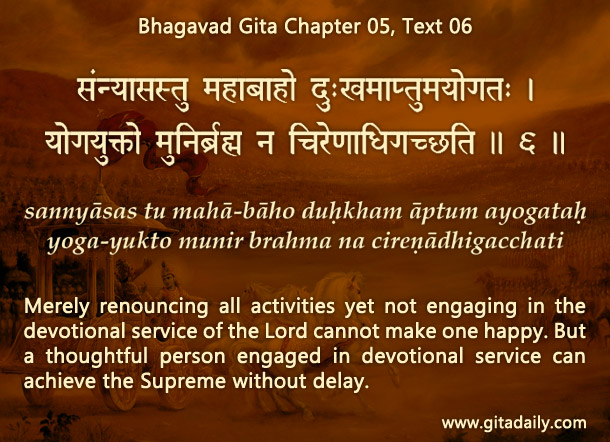The Bhagavad-gita begins with a rigid differentiation between matter and spirit (02.11-30), wherein the properties of the spiritual particle, the soul, are shown to be radically opposite to those of the material unit, the body (02.23-24),
Significantly however, the Gita doesn’t take this approach of rigid differentiation from categorization to application. That is, though it categorizes reality into two significantly different levels — matter and spirit —- it doesn’t equate the path of material engagement with entanglement and the path of renunciation with liberation. When Arjuna presumes such equalization, the Gita calls his understanding naive (05.04). It explains that liberation from material entanglement can’t be had merely by stopping activity or renouncing responsibility (05.06); the spiritual level of reality can be reached only by the progressive elevation of our consciousness. And such elevation requires steady, systematic endeavor using the resources we presently have: our material body and mind. Thus, the path to the spiritual world isn’t opened merely by turning our back to the material world; it frequently requires walking through the material world with spiritual intention.
In outlining how to live spiritually in the material world, the Gita endorses varnashrama, the fourfold division of human society into functional occupations and individual positions. Still, it doesn’t deem any occupation or position as intrinsically spiritual, though all are potentially spiritualizable. All occupations and positions can us spiritualize our consciousness. The culmination of the Gita’s dynamic harmonization of matter with spirit is its call to work in a mood of worship (18.48); Arjuna’s spiritual path is not by renouncing his martial duties as mundane, but by embracing them as a sacred means for social contribution and personal emancipation.
One-sentence summary:
Differentiate between matter and spirit for philosophical categorization and harmonize matter with spirit for spiritual elevation.
Think it over:
- When and why does the Gita differentiate between matter and spirit?
- When and why does the Gita not differentiate between the material and the spiritual?
- What is the culmination of the Gita’s dynamic harmonization of matter and spirit?
***
05.06: Merely renouncing all activities yet not engaging in the devotional service of the Lord cannot make one happy. But a thoughtful person engaged in devotional service can achieve the Supreme without delay.


Matter is BODY, and spirit is SOUL.